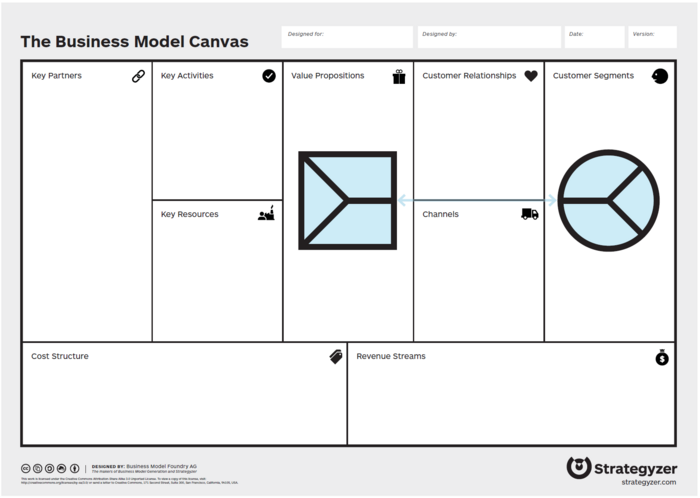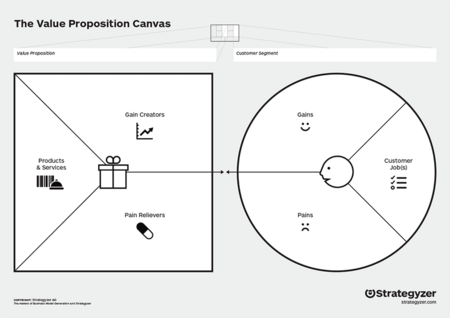Value proposition canvas
| Line 6: | Line 6: | ||
== Description == | == Description == | ||
| − | [[File:val.PNG|thumb|<ref name = ValueDesign>Alexander Osterwalder et al., ''Value Proposition Design'', 2013.</ref>The image illustrates the 9 building blocks of the Business Model Canvas. The Customer Segments and Value Propositions blocks are used in the Value Proposition Canvas.|700px]] | + | [[File:val.PNG|thumb|<ref name = ValueDesign>Alexander Osterwalder et al., ''Value Proposition Design'', 2013.</ref>The image illustrates the 9 building blocks of the Business Model Canvas. The Customer Segments and Value Propositions blocks are used in the Value Proposition Canvas. The image is from ''Value Proposition Design'' by Alexander Osterwalder et al. |700px]] |
| − | [[File:Value proposition canvas.png|thumb|<ref>https://strategyzer.com/canvas/value-proposition-canvas/</ref>The image illustrates the Value Proposition Canvas. The model is split into two parts: The value map (left) and the customer profile (right).|450px]] | + | [[File:Value proposition canvas.png|thumb|<ref>https://strategyzer.com/canvas/value-proposition-canvas/</ref>The image illustrates the Value Proposition Canvas. The model is split into two parts: The value map (left) and the customer profile (right). The image is from strategyzer.com.|450px]] |
Project management is using tools, skills and knowledge in order to meet project requirements and can be done through project management processes <ref>https://sd-ds-dk.proxy.findit.dtu.dk/Viewer/Standard?ProjectNr=M268368&Status=90.20&VariantID=46&Page=0</ref>. In project management a project manager must use his skills and tools in order to meet project requirements as well as the wants of customers/stakeholders. Project management can be categorized into five process groups: Initiating, Planning, Executing, Controlling and Closing. | Project management is using tools, skills and knowledge in order to meet project requirements and can be done through project management processes <ref>https://sd-ds-dk.proxy.findit.dtu.dk/Viewer/Standard?ProjectNr=M268368&Status=90.20&VariantID=46&Page=0</ref>. In project management a project manager must use his skills and tools in order to meet project requirements as well as the wants of customers/stakeholders. Project management can be categorized into five process groups: Initiating, Planning, Executing, Controlling and Closing. | ||
In the initiating process group the scope of a project and stakeholders/customers are identified. The needs and expectations of the stakeholders are identified. A project manager must communicate with stakeholders in order to analyze their needs and concerns <ref name=pmbok/>.. The project manager can use the Value Proposition Canvas as a tool to understand and analyze the stakeholders. | In the initiating process group the scope of a project and stakeholders/customers are identified. The needs and expectations of the stakeholders are identified. A project manager must communicate with stakeholders in order to analyze their needs and concerns <ref name=pmbok/>.. The project manager can use the Value Proposition Canvas as a tool to understand and analyze the stakeholders. | ||
Revision as of 17:15, 26 February 2018
In order to provide customers with good service and valuable products, an organization should define their value propositions for their projects. In order to create successful projects a project manager must use his skills and knowledge to plan projects and create project plans to meet the project and product requirements by the customers [1]. The value propositions set by the organization for their specific products can guide the project managers to develop project plans that satisfy their customers and provide them with valuable products. The Value proposition canvas is a tool that can be used in order to solve the problems of specific customer segments and fulfill their needs by providing products and services that creates value for the customer. The organization should design value proposition with benefits in order to attract customers and make them choose one company rather than its competitors [2]. The project manager has to make sure that the value proposition and customer profile complement each other so that the customer segment is provided with the right products/service and that the customer’s pains are met with the right pain relievers [3].
This article will describe the value proposition canvas and the importance of choosing the right value proposition. The relation between project management and the canvas will be described along with how the canvas can be used to satisfy customers and stakeholders.
Contents |
Description


Project management is using tools, skills and knowledge in order to meet project requirements and can be done through project management processes [6]. In project management a project manager must use his skills and tools in order to meet project requirements as well as the wants of customers/stakeholders. Project management can be categorized into five process groups: Initiating, Planning, Executing, Controlling and Closing. In the initiating process group the scope of a project and stakeholders/customers are identified. The needs and expectations of the stakeholders are identified. A project manager must communicate with stakeholders in order to analyze their needs and concerns [1].. The project manager can use the Value Proposition Canvas as a tool to understand and analyze the stakeholders.
Identifying and choosing the value propositions are an important part of creating value for the customers and stakeholders. However, it is not enough to only design the value propositions, it is also important to integrate a business model in order to create value for the organization. The Business Model Canvas can be used for this purpose. [2].
Business Model Canvas
[2]. A business model is game plan for implementing strategies through organizational processes and systems. The Business Model Canvas consists of 9 building blocks and can be used as a tool to describe how an organization creates and delivers value. To quickly sum up the Business Model Canvas:
- Customer Segments: Group or people that the organization wants to create value for with value propositions
- Value Propositions: Products or services that creates value for a particular customer segment
- Channels: How value propositions are delivered to a customer segment
- Customer Relationships: Establishment of relationship with particular customer segments
- Revenue Streams: Result from successfully delivered value propositions to customer segments
- Key Resources: Required assets to provide the elements described above.
- Key Activities: Important activities that the company must execute well.
- Key Partnerships: External suppliers and partners
- Cost Structure: Cost to meet a business model
The left side of the Business Model Canvas concerns the organization (internal), while the right side concerns the customers (external). Both the internal and external forces meet around the value propositions. In the Value Proposition Canvas the two blocks Customer Segments and Value Propositions are used to describe how the organization creates and exchanges value with the customers/stakeholders[2].
Value Proposition Canvas
Alexander Osterwalder describes the Value Proposition Canvas as a 'Plug-in' to the Business Model Canvas allowing the project manager to zoom in on how to create value for the customers. [3]. The Value Proposition Canvas looks at two parts - the value proposition map and the customer segment map. The value map describes how the project manager intends to create value, while the project manager shows their understanding of their customers in the customer profile.
The value proposition can be split into: Products & Services, Gain Creators and Pain Relievers.
- Products & Services: The bundle of products and services that the value propositions are built on and that the organization offers their customers in order to satisfy their needs.
- Gain Creators: How the products or services benefits the customers. It describes how the project manager plans to create gains for the customer.
- Pain Relievers: How the products or services eliminate the potential pains or annoyances the customer might have. Details how the project manager will remove pains.
The customer map can be split into: Customer Jobs, Gains and Pains
- Customer jobs: Describes the tasks that the customers try to finish, problems they try to work out or needs to satisfy. The project manager has to use the customer's perspective when analyzing the jobs.
- Gains: The benefits the customers wishes to see.
- Pains: The challenges the customers face when getting a job done. The project manager must identify the pains and its severeness in order to produce pain relievers-
When the value proposition map and customer segment map meet each other, the project manager achieves a fit. The project manager achieves a fit when customers are satisfied with the value propositions, which focuses on important customer jobs, relieves extreme pains and creates fundamental gains[4][3]
Application
After designing a value proposition that seems promising for the customer, the project manager must test it. It is important to test the value proposition in early stages in order to make adjustments and improve the value proposition. The project manager must decide whether the services or products that the customer wanted has been delivered and whether they've achieved their benefits and had their pains alleviated. The project manager must test the value proposition together with the customer step-by-step in order to investigate whether the value proposition fulfills the needs of the customers and creates value for the customer. It is up to the customer to decide whether the value proposition creates value for his business or not [7]
Common Mistakes
Example: Tesla
Tesla produces electric cars. When Tesla set their value proposition for producing their electric cars, the jobs that had customers wanted was comfortable travel as well as portraying success and uniqueness. Some of the pains that customers had with electric cars was weak batteries and lack of charging stations for their cars and having to charge their cars often. The gains that the customers expected to see was high-tech, well-designed cars with strong batteries. Tesla managed to create a fit between their customer segment and their value proposition. By providing beautiful and high-performing cars with well-functioning battery technology, they managed to satisfy their customer's needs. Adding an 8 year-old battery warranty also created a pain reliever next to producing the cars. [8]
Further Reading
Alexander Osterwalder & Yves Pigneur: Business Model Generation, 2010
- Learn about the Business Model Canvas to learn about creating value and improving organizations. The book describes how to use business model in order to position an organization in a competitive advantage and re-designing an organization's business models.
Alexander Osterwalder et al.: Value Proposition Design, 2013
- Learn about creating desirable products for customers and the processes and tools in order to create and sell the products.
Office Of Government Commerce: A Guide to the Project Management Body of Knowledge (PMBOK® Guide), 2013
- Learn about fundamental practices that drives businesses and that reflects the current industry knowledge and practises.
References
- ↑ 1.0 1.1 Office Of Government Commerce, A Guide to the Project Management Body of Knowledge (PMBOK® Guide), 5th Edition, 2013
- ↑ 2.0 2.1 2.2 2.3 Osterwalder, Alexander and Pigneur, Yves, Business Model Generation, 2010.
- ↑ 3.0 3.1 3.2 https://lederindsigt.dk/vaerktoejer-skabeloner/strategi-og-forretningsudvikling/value-proposition-canvas/
- ↑ 4.0 4.1 Alexander Osterwalder et al., Value Proposition Design, 2013.
- ↑ https://strategyzer.com/canvas/value-proposition-canvas/
- ↑ https://sd-ds-dk.proxy.findit.dtu.dk/Viewer/Standard?ProjectNr=M268368&Status=90.20&VariantID=46&Page=0
- ↑ https://www.toolshero.com/marketing/value-proposition-canvas/
- ↑ http://designabetterbusiness.com/2017/10/12/how-to-really-understand-your-customer-with-the-value-proposition-canvas/.